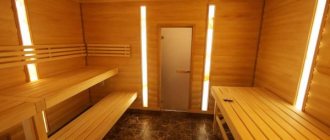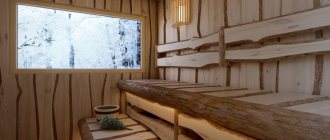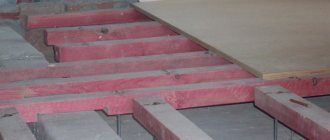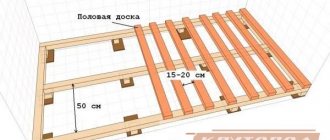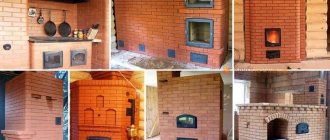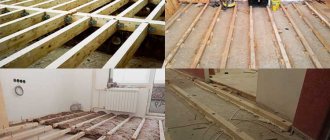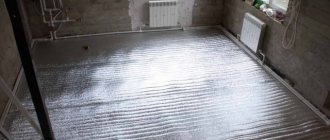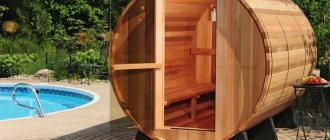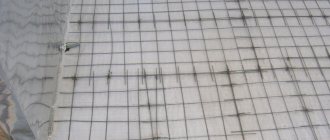Practice shows that in ANY house or bathhouse there are places or structures for the manufacture of which it is desirable to use wood species that are particularly resistant to decay. Usually these are FLOORS in the house, floors of open vernades, terrace boards, boards on an open or closed veranda under a canopy or deck boards, solid wood floor boards used in wet places, near swimming pools, in baths, steam rooms, saunas, etc. To reduce the risk of damage to the floorboard and extend the time of effective operation of the floor from the moment it is laid to the renewal of the floor covering, it is possible and recommended to use larch boards and floors. Larch wood is particularly resistant to damage from moisture and does not rot for a long time. It is even used to make a lining beam, a lining board or the lower crowns of a wooden house, on which a frame made of pine, fir, aspen, etc. is laid. But having chosen larch as a building material or made floors from larch, we may be faced with the task of selecting a finishing protective impregnation for a given type of wood, that is, how to paint and treat the larch floor. The thing is that it is difficult to apply varnishes and paints to larch wood and lumber due to its specific properties - natural oiliness, which prevents the “sticking” of surface paints and varnishes and quite high friability, which affects the degree of change in the geometry of the board when humidity changes treated wooden surface. Ordinary varnishes and paints practically DO NOT last on larch floorboards, or the protective coating treated with varnish and paint for wood on larch turns out to be NOT durable at all. It is safer to treat larch floors with impregnation, which does not peel off, does not form a hard surface film, but protects the wood from moisture and allows the wood to “breathe”, i.e. OIL and WAX.
We save wooden floors in a bathhouse from rotting: the best impregnations and methods of their use
We treat the floors in the bathhouse “The weaker sex are rotten boards” (Faina Ranevskaya) Good day, reader!
So I thought about the meaning of the bathhouse in my life. And I couldn’t answer myself, what is this? hygiene or traditional long-term ritual. What do most men remember in damp, chilly weather? - about a steam room with a fragrant whisk.
I am wrong? The feeling of spiritual flight is given by a simple heated wooden room, which has retained its unchanged appearance over the centuries. Unfortunately, concerns about maintaining its proper appearance also remained unchanged. Wooden floors especially require them. So, today’s topic is how to treat the floor in a bathhouse from rotting.
A little about sad things. The floors in the bathhouse are rotting. Sooner or later you will have to re-cover it. Even if the boards look perfect and there are signs of rotting, no, this does not mean that everything is in order. Competent builders determine the presence of a process by knocking. Rotten wood will produce a dull sound.
To begin with, I’ll tell you why this happens in the bathhouse (although the reader can guess without me). There is only one reason - moisture. Moreover, in the most extreme manifestation - multiple cycles of getting wet and drying, plus sudden temperature changes. The main question is what needs to be done to slow down the process of inevitable wood rotting?
Tips for choosing antiseptics
When choosing products for treating a wooden floor in a bathhouse, you need to know what properties they should have:
- Water-repellent properties, since water creates favorable conditions for the development of pathogens. To prevent them from appearing, it is necessary to ensure that the wooden panels of the room are dry. Impregnation provides a protective layer that prevents moisture from penetrating the flooring.
- Repellent substances, since the tree is susceptible to damage by rodents and insects. So, impregnation containing a repellent component will prevent pests from infesting, ensuring the safety of the floor covering.
- The impregnation must contain antiseptic elements (phytoncides), which are destructive to mold and mildew.
What is rotting, what impregnations protect against it?
One of the reasons why we found it necessary to write this review was the widespread illiteracy of people writing about wood rot and means of protection against it. You read such rare nonsense that you become scared - what if in other areas where you don’t understand, they just as cheerfully tell you nonsense?
Composition for baths 2.7 l. Saunasuoya soup for protection against moisture and dirt. Banka Photos
Mold is harmful due to its toxins and spores. Toxins are harmful if eaten - as some do when they cut off the moldy side of an apple, considering the rest healthy, but not realizing that the visible mold is its fruiting body, and the hyphae penetrate the entire apple. But we don't eat the tree, so spores are the main type of damage caused by mold growing on the tree.
spores in the air, they cover objects, but are activated only in the presence of moisture. In normal concentrations, our body copes with spores that penetrate it. But when there is a colony of mold in residential or bathing areas, the concentration of spores grows so much that this becomes the cause of mycotoxicosis, allergies and many diseases that at first glance cannot be associated with mold at all - migraines and heart disease, otitis media, rhinitis, bronchitis , etc. .P.
IMPORTANT! You shouldn’t believe Wikipedia that mold destroys wood, but you should definitely be afraid of it and fight it. It is also necessary to distinguish between rot and mold, because the means of combating them are different.
The very mechanism of wood destruction by fungi boils down to the fact that their hyphae eat away cell walls with enzymes, leading to their corrosion or destruction (they differ in the scale of dissolution - in the first case, holes are formed in the cell walls, in the second the walls dissolve entirely). The contents of the cells become stained, which leads to the darkening of rotting wood.
There are quite a few types of fungi that cause rotting, and they belong to different classes. Therefore, substances that successfully cope with some types are useless against others.
ATTENTION! There is no universal fungicide. Only compositions are possible that complement each other, affecting species over which the other has no control. But we have not found a single ready-made product that would work in this way. Only fungicides with limited spectrums of action are commercially available.
But what’s even sadder is that many fungicides that are sold specifically for baths are effective only against molds and staining fungi! And they sell them as a remedy for rot, taking advantage of the general illiteracy of buyers.
Why is that? Yes, because remedies for mold and staining fungi are simple antiseptic impregnations based on boron or chlorine. But the real remedies against rot are high-tech chemicals , expensive and imported. We simply have no other explanation. And that is why you will almost never see the composition on the label. The most you can count on is a streamlined statement that the composition contains “highly active biocides” or that the product “does not contain heavy metal salts.”
ADVICE! If you want something effective, look for imported products with clearly stated ingredients on the label and expensive ones.
In different rooms
How do different sauna rooms differ from each other? The amount of water falling on the floor. There is more washing water on the floor. In the steam room... if it is a sauna, then there will be little water, in a Russian steam room there will be more.
NEOMID Sauna - acrylic-based wood protective varnish
How does this relate to impregnation of bathhouse floors against rotting? Yes directly. If the impregnation is water-soluble, and these are the ones recommended for indoor use, then the water will wash it away unless a layer of protection in the form of varnish or at least a water-repellent impregnation is applied on top.
ON A NOTE! Impregnations for bathhouse floors are generally recommended to be used either in the form of a ready-made primer, or as an independent product as the first layer before painting with varnish or impregnation with oil.
Steam room: protection from moisture
A special feature of the steam room is the increased temperature, which promotes the evaporation into the air of various impregnations used by manufacturers, say, mineral wool and wood. In general, everything that can go into a volatile state does so when the temperature rises.
Water antiseptic for baths and saunas Neomid 200 Proff 1 l. Photo by Leroy Merlin
However, even in a steam room, the floor is the lowest temperature area , because hot air is supposed to rise up, because it is lighter in weight than cold air. The exception is the area near the stove . But we sincerely hope that you have placed a large sheet of mineralite and stainless steel . It is placed against sparks and at the same time will protect the floor from overheating.
So, we claim that the floors in the steam room do not get that hot. Therefore, there is no reason for the main fears that something harmful will begin to be released from them. This opens up wide possibilities for covering them with various impregnations for wooden floors in a bathhouse, and even with varnishes (for example, yacht varnishes).
Washing
The wettest place in the bathhouse. Therefore, it is recommended to make the floors here from ceramic tiles, but if they are made of wood, then yes, they really need impregnation.
Temperatures in the washroom are generally moderate, so near the floor the temperature will be about the same as in the break room. This suggests that the evaporation rate will not be high, but the impregnation of the floor boards should be quite serious from what is offered for interiors .
Do not forget that impregnation is done before the finishing coat.
Rest
The remaining rooms of the bathhouse include: a relaxation room, a bathroom, and a dressing room. Not all bathhouses have them, but as for the impregnation of floors, here it will be the same, since the operating conditions are approximately the same.
Antiseptic varnish EUROTEX Aqualazur White 2.5 l. Photo Petrovich
The best option is to take varnish or paint with a primer, which already contains an antiseptic. Then everything will be decided in the shortest possible time, because they usually take primer and paintwork materials from the same manufacturer, which are compatible with each other.
Conclusion
Floor coverings made from Siberian larch, despite the relatively high price, are becoming increasingly popular. No wonder. This type of wood has many advantages that will help you create reliable, warm, moisture-resistant and beautiful floors.
In the video presented in this article you will find additional information on this topic.
- Make sure that there are expansion joints about one centimeter wide between the outer boards and the walls of the room. They can be covered with floor skirting boards.
Wood floor protection
Now it's time for specifics. We have already mentioned above that only those impregnations for the floor in a bathhouse against moisture and rotting that are marked “for interior use” are suitable for interior use.
We will not be able to cover the entire impregnation market. The most famous companies in Russia producing antiseptic impregnations are Neomid and Senezh. In their product catalogs you can find the following options suitable for floors:
"Senezh Aquadecor" is a tinting and antiseptic composition based on acrylates, alkyds, linseed oil and wax. In our opinion, it is a real chimera, consisting of incompatible parts. Alkyds dissolve in organic matter, acrylates - in water, oil and wax in water give a suspension... Nevertheless, the manufacturer allows them to cover indoor floors with the condition of further painting with abrasion-resistant varnish, promising protection against rot, mold and blue stains.
“Senezh Ecobio” is a floor primer with the same total protection from everything as the previous two options. Can be used on its own where there is no water washout. But since you will be washing floors everywhere, it is better to use it as a primer.
Antiseptic for baths and saunas NEOMID 200, 0.5 l., concentrate. Photo by Maxidom
“Senezh Ultra” looks like heavy artillery. It will do where the rot started. Judging by the pistachio color of the wood, it contains copper compounds. This is good. Nothing is said about impregnation of floors, but we think that this impregnation will be useful for those who have already started having problems with them. Hazard class IV – “low hazard”.
"Senezh" is an even heavier artillery for wood in difficult operating conditions. They are talking about contact with water and soil. Can only be used for joists and other critical structures, but not for the floor itself, at least not for finishing.
"Senezh Bio" - suitable for baths and tropical climates
Source
Properties of wood
Larch has long been valued for its exceptional moisture resistance and weather resistance.
Distinctive features
- Thanks to its resinous substances, sexual larch does not deform during prolonged contact with moisture, does not rot, and maintains a natural microclimate and air exchange in the house.
- The gum contained in its wood is a natural antiseptic. Therefore, harmful microorganisms and insects are not harmful to the floor covering.
- Being valuable for its set of qualities, but not for the characteristics of the workpiece, this species is much cheaper than, for example, oak or teak. Therefore, the price of larch lumber is very attractive for domestic construction.
The texture of larch is very aesthetic.
- The color range of wood is very wide and contains 12 shades from golden to soft pink. On lumber from the tree described, growth rings are clearly visible, forming the artistic basis of the coating. Tangential cuts, which are especially prized, best reveal the delicate texture of a honey-wheat tone, aesthetic shine and small fibrous ripples.
Note! Larch is the only hard coniferous species. In this parameter (coefficient 3.2 on the Brinell scale) it is not inferior to beech and oak. Moreover, over time, the density and strength of the material only increases.
- The covering made of this wood perfectly retains heat.
- Often, owners of dachas and suburban areas have a question about what material to use for flooring in a bathhouse. Traditionally, Russian steam rooms are built entirely of wood, but it does not have good moisture resistance. However, this does not apply to larch. With prolonged interaction with water, materials from it do not rot, but petrify.
Grade of raw materials
- Timber of the “Elite” (“Extra”) grade should not have any wood defects.
- Larch for flooring of medium selection, that is, grade A (“Natur”) can have sharp changes in color. Two non-falling (live) knots with a diameter of up to 1.5 cm or two resin pockets (dimensions up to 80×2 mm) per linear meter are allowed.
- In grade B (“Rustic”), the shade of the boards may vary; dead knots are acceptable, which emphasize the naturalness of the planks.
Characteristics of the floor in a larch bath
Larch is a coniferous tree that is used in finishing objects with high humidity. The physical and technical parameters of the material ideally meet the requirements for bath coverings:
In terms of hardness, resinous larch boards are second only to oak; It is impossible to drive a nail into dry material. It is not for nothing that larches were used in the construction of ships; they withstood any storms. Even at very high humidity, the material lasts thirty years.
pros
With all the above properties, the advantages of larch over other materials include:
Minuses
Larch boards have few disadvantages, and they are relative. Thus, if the rules of wood processing and proper drying are violated, the board may turn out to be of poor quality. It is not used when installing a “warm floor” system. It is also not recommended to install flooring on a terrace or in a dressing room in areas with a huge difference in winter and summer temperatures, as this shortens its service life.
Types of larch for bath floors
Each variety is suitable for a specific bath room. So, directly in the washing room, where it is always humid, they must use an elite grade of board. In the steam room and dressing room, it is enough to put a board of the middle grade segment.
Boards are also divided into types:
The most practical material is the last one listed. It is used in the installation of non-spillable bath floors. Thanks to the locking system, the planks are connected to each other efficiently and fit tightly. Such floors are not afraid of any disasters.
Most popular materials
The photo shows a floorboard.
Larch produces many types of materials that can be used for flooring.
Grooved floorboard
The most common type of wood flooring inside houses, apartments, offices, etc.
- Such boards have a tenon on one longitudinal side and a groove on the other.
- Some manufacturers make compensation cuts on the back of the planks.
- Such larch is joined to the floor closely.
- Tongue and groove floor boards have different widths (8/20 cm), lengths (2/6 m) and thickness (2/4.5 cm), which must be selected based on how the covering will be laid: on joists or a subfloor.
Deck strips
This type of board is suitable for flooring both in open spaces and inside wet rooms. As the name suggests, such lumber was previously used for cladding ship decks. Nowadays, it has also been used on land. Using deck boards, floor coverings for balconies, terraces, gazebos, and verandas are laid.
Larch is ideally suited for such premises, as it practically does not absorb water, is resistant to warping and is very dense. Traditionally, smooth decking boards are not laid close to each other, but with small gaps. Deck cladding is ideal for rooms with high levels of humidity.
Features of laying larch on the floor in a bathhouse
As connecting elements to the base, they use not nails, but self-tapping screws, making holes for them. When installing with glue, it is recommended to use two-component compounds for reliable bonding.
To avoid severe deformations, a technological gap of up to 4 cm should remain between the wall and the slats.
When installing leak-proof larch floors, plywood sheets are placed under the planks to minimize the contact of the wood with the screed.
Source
Conclusion
Floor coverings made from Siberian larch, despite the relatively high price, are becoming increasingly popular. No wonder. This type of wood has many advantages that will help you create reliable, warm, moisture-resistant and beautiful floors.
In the video presented in this article you will find additional information on this topic.
Good day. Tell us your impressions of using larch floors in a steam room-sink in a bathhouse. What problems did you encounter during operation? Is it worth oiling or patching them? Thanks in advance everyone.
No duplicates found
The foliage is cold, almost always. In my bathhouse, holes are drilled in the floor, 1 cm in diameter. High-quality stitching and subsequent finishing with sandpaper will save you from splinters. Didn't impregnate it with anything. It lies like that.
They are tarred. In general, this is overkill. Enough pine. Enough for 10 years. Do it with half-centimeter gaps
Never turned black. Planed, chamfered and that's it. Third sauna in 30 years
"In advance". Is the penultimate sentence a statement? “Operational feel”? Again, you wish “Good day” without enthusiasm (at the end there is a period). Author, please re-read the text at least once before publishing. In terms of style and grammar, it looks more like a chat message rather than a post.
There’s nothing to say about the essence of the question, but I couldn’t pass by, it hurts my eyes.
A bathhouse is a room with a specific microclimate that has a beneficial effect on the development of pathogenic bacteria. The appearance of mold or mildew in rooms of this type is not uncommon, as they love humidity and warmth. Why this problem occurs and how to deal with it, we will consider in this article.
Wooden finishing of the interior of the bathhouse
The best impregnation for baths inside and outside
In the photo: finishing the steam room of a bathhouse with wood (lining)
Anyone who wants their bathhouse to last as long as possible is considering various options for extending its life. Various impregnations are just among the products that promise just that. But let's find out what they are and where they are most appropriate.
For this purpose, we decided to divide our article into two parts, devoting one of them to impregnations for the bathhouse inside, and the other to the outside.
The difference is obvious - everything that is outdoors is exposed to solar ultraviolet radiation and seasonal precipitation, frost and heat. This suggests some aggressive response. And what is inside the bathhouse should be as harmless as possible to humans, but still quite effective, because the bathhouse has high humidity.
Which are the best for outside treatment?
Let's start with the outside. It can be made of wood in two cases: when the wall is made of wood - timber or round timber, and when it is lined with wood. In this case, either clapboard for external cladding or board can be used.
Bathhouse with a large relaxation room
As for impregnations, they are divided into two categories: for protection against biological damage (antiseptics) and/or fire retardants and for protecting wood from the effects of nature and weather (coatings).
The antiseptic agents that are used to impregnate the outside of the bath will not differ for boards and logs, because in our case they are all intended for manual application . This means that their depth of penetration into wood is limited to a maximum of 5 mm, but in reality it is even less.
Therefore, it is advisable to approach the impregnation of bathhouse timber more responsibly and use stronger antiseptics.
For log and timber
Ideally, for the outside of a log bathhouse, impregnation made in an industrial environment . But it covers the entire surface layer of the log, which is not good for a steam room if it is not insulated and lined with clapboard. If the walls are covered (only in the steam room), then impregnated wood should be considered the most protected from rot and mold.
You can read in detail about what it is and what compounds are used there.
Applying antiseptics manually, as already mentioned, is less effective, but fairly strong formulations can be used.
In general, it is recommended to pay attention to those compounds that are designed for outdoor use.
An example of a good option for impregnating the outside of a log bathhouse is the “Valtti” . They are sold with an antiseptic primer. Ideal compatibility option.
Let me explain. to peel off after three years in the harsh Russian winter Oil impregnations are better in this regard because they form a more elastic coating. The same applies to acrylate compounds.
Actually, here it is. We coated the wood with an antiseptic, after which the impregnated layer must be protected from washing out and destruction by ultraviolet radiation. Therefore, pay attention to the presence of UV filters in the product you will use to coat the antiseptic.
What is good about exterior impregnation of a log house with oil? Thanks to it, the logs will crack much less , because the oil makes the wood less fragile. In our opinion, this is the best impregnation for the outside of a bath. You can use both domestic and imported oils. The main thing is that they are intended for facades, contain UV filters and are resistant to temperature changes and precipitation.
Impregnation for baths and saunas inside
If external impregnation has already become more or less clear, you can move on to the extensive issue of internal impregnation.
How does internal impregnation differ from external impregnation? If we are talking about antiseptics, then the degree of aggressiveness. After all, all antiseptics are poisons not only for mushrooms or insects, but also for people. It’s just that now these are low-toxic substances, but before there was a nightmare of arsenic and chromium. However, indoor antiseptics should be even safer.
If we talk about impregnations for wood in a bathhouse for interior work, then these are not paints, which can be more harmful if used outside. Impregnations will differ only in the presence or absence of additives that protect the wood from the sun and other environments. Such additives are not needed indoors.
For lining
Lining is a thin profiled board. What is it impregnated with and why? Of course, any wooden part when moistened is at risk of infection by fungi that cause rotting or mold. the washing room and (attention!) near the floor in the steam room needs antiseptic protection .
Impregnation for lining in a bathhouse
Let us explain: the temperature near the floor, even in the steam room, is not that high, and the lower lining often gets wet. An antiseptic may or may not be used if it is replaced with high-quality ventilation and drying (see the section on ventilation), as well as some life hacks, the point of which is to prevent the lining from coming into contact with the floor.
So, if an antiseptic for lining is needed, it is in limited quantities . In the washing room, a primer for (interior) acrylate varnish will be sufficient.
We also recommend reading the article about all types of lining treatment in a bathhouse, inside and outside, or watching its video version below.
For boards
Lining is also “boards”. But even with ordinary edged (or even unedged) boards, a bathhouse can be sheathed inside and out. low-cost option , so we will not say that such a bathhouse should be covered with compounds purchased for a lot of money from the Finns.
Impregnation for boards in a bath can be quite inexpensive if you use an old and proven recipe for a mixture of linseed oil and wax . Watch the video, which clearly demonstrates the process of preparing such a composition and its application in practice. And note: the owner of the bathhouse was happy to cover it with it inside and out!
For floors
Again the same point: impregnations are antiseptic and water-repellent. Both are in demand for floors, because there is dampness from the underground, and moisture from the steam room and washing room (you shouldn’t think that if water doesn’t pour onto the floor, then everything is dry, there is also moisture in the air, which condenses instantly, if there is a cold surface).
There is a lot of moisture in the bathhouse. Therefore, it must be dried and protected. We recommend covering the floors with some kind of interior antiseptic, but on the condition that the seller or manufacturer was able to assure (or better yet, prove) that this antiseptic protects not only from mold, but also from rot. We have said more than once that these are different types of mushrooms that require different compositions.
can be applied over the antiseptic . Typically, special paints and varnishes with additives are used for flooring, which increase their wear resistance. In particular, these are urethane and polyurethane additives. They are needed because we constantly wear down the flooring with our feet.
yacht varnish as a finishing coating which is not afraid of moisture. However, here we go beyond the scope of our topic. Because varnishes are not impregnations. We have a separate material about impregnations for bath floors.
On the other hand, using oil to impregnate the floor inside a bathhouse is a bad idea. Of course, there are oils that do not cause slipping. But the fact is that oil impregnations do not provide a coating that is resistant to abrasion. And they give varnishes. Therefore, wooden floors are coated with varnish.
Types of compositions for interior work
We have already said a lot above about various impregnations, but it’s time to clarify what exactly you may find on sale.
We will separately consider water-repellent and antiseptic impregnations.
Mixtures for wood: with wax and oil
Pure wax for impregnating wood is used in limited cases. This operation is called waxing, it is applicable to furniture, but our case is different.
The task of water-repellent impregnation is inherent in its name. In addition, it allows the wood not to absorb dirt, sweat and grease. Another couple of important advantages are a reduction in the swelling of wood (you don’t think that after impregnation it will completely stop absorbing moisture? In fact, its amount will become much less), as well as an increase in its elasticity, that is, it will not crack after drying.
Therefore, the basis of impregnation is oil. It comes in flax and paraffin.
Paraffin oil is made from petroleum. It is as safe as flaxseed. In particular, paraffin oil can be bought from Tikkurila, it is called “Supi Laudesuoya”.
Impregnation for shelves in the Tikkurila steam room - Supi Laudisuoja. Banka Photos
By the way, the same company has an impregnation for baths inside with wax, which is called “Supi Saunavaha”. Water-soluble, which means that there is not only wax, but also something that polymerizes when it dries. There are no ingredients on the label.
Flaxseed oil is more traditional, it can be found in many varieties, both domestic and imported. You can buy pure raw (or boiled) flaxseed oil at a pharmacy or in a regular supermarket. Even in this form it can be used as an impregnation, but it will take three days to dry one layer.
Usually the buyer is offered a composition that requires much less time to dry. Boiled butter requires less time to polymerize. Dryers also reduce time, but their use here is inappropriate.
The mixture of oil and wax is called oil wax. Such compositions can be of varying degrees of solid-liquid. Liquid formulations are more convenient to apply, but they have higher consumption.
There are a lot of impregnations. Almost every company that has something for a bath produces such impregnations. Therefore there is no need to list. Decide what is more important to you - price or the authority of a large company. And so, by and large, even what you can do with your own hands will be of very good quality. You use natural ingredients.
Antiseptics
You can also learn about what types of antiseptics can be found on the market from this article of ours. However, here we will briefly go through some of the major market players that everyone knows about.
"Senezh"
produces a whole range of antiseptics that can be used for both internal and external work, that is, you have the opportunity to buy everything you need to protect wood from this company.
Impregnation Senezh and brush
Structural parts such as joists and beams that will not be visible can be treated with a strong, non-washable antiseptic. For example, “Senezh Ultra”, “Senezh”, “Senezh Bio”.
Non-washable is not suitable for facades, because it gives a green color to copper salts. Therefore, weaker compounds are used, but they do not produce coloring (at least in unnatural colors). For example, "Senezh Aquadecor".
Inside, you should use even safer options, which are marked that they are suitable for interior work - “Senezh Ecobio” .
“Senezh Sauna” was developed . To stand out in the market, they added antimicrobial agents. But it is not recommended to use this antiseptic on shelves.
"Neomid"
The products of this company are widely advertised and are known to many. For baths, she has developed such impregnations as “Oil for baths and saunas” - already with an antiseptic, as well as the composition “Neomid 200” , which is suitable for antiseptic steam rooms.
Antiseptic for baths and saunas NEOMID 200, 0.5 l., concentrate. Photo by Maxidom
The rest of the impregnations from this manufacturer are universal for any interior and exterior work. In particular, to protect wood from biological damage, you can use Neomid 400 Neomid 440 outside
There are other options in the catalog on the company’s website that are suitable for building elements under heavy-duty conditions. As well as a series of comprehensive protection against fire and biological damage. Below is a video about using this manufacturer's anti-mold composition.
"Tikkurila"
Well, this name is definitely on everyone’s lips. We have already mentioned their impregnations for baths and saunas inside. Let us repeat - these are “Supi Laudesuoya” and “Supi Saunavaha”.
In addition, the company offers oil for shelves, as well as protective compounds for walls and ceilings, but they are no longer impregnations, but acrylic varnishes. Antiseptic additives are already included in these formulations - “Supi Arctic” and “Supi Saunasuoya”.
For the floor they have Supi Lattiaoljy .
Step-by-step instructions for building a log house
If the bathhouse is built entirely from larch, there is no need to search for specific materials for the foundation. This type of wood is optimal for arranging the foundation for a building and creating floor joists.
The work is carried out in the following order:
- The foundation is covered with waterproofing material; roofing felt is most often used as a budget solution.
- Next, the first crown is formed, it is also called the frame. This row will end up being a little wider than the rest. Bitumen is placed into the voids that inevitably form between the flashing and the foundation; the cracks can be sealed with polyurethane foam or mortar.
- The most aesthetic way to create crowns is considered to be the classic “butt-top” technique. With its help, conditions are created for adherence to the horizontal level, as a result the design looks aesthetically pleasing and neat.
- Previously, the space between the crowns was filled with moss dried in a special way; now it is customary to use tow, construction and insulating fibrous analogues. The main thing is that the materials must be resistant to drying out and rot.
- The end connecting notches can be designed in any form, the methods “in the head”, “in the paw”, “in the bowl” are practiced. The logs are connected to each other using dowels. After the formation of 3-4 crowns, the raw material is impregnated with waterproof mastic and, if necessary, tinted.
- The last two (that is, the upper) crowns do not need to be fixed; they are removed after the timber has undergone shrinkage in order to install the ceiling beams.
- The log house must be stable, only after that they begin to arrange the roof. This process can take several months, the specific timing depends on the construction season and the climate in the region.
Construction of a bathhouse from larch
Upon completion of the shrinkage of the logs, the roof is covered with ceramic or bitumen tiles or slate. It is advisable to organize some elements of interior decoration using the same larch; they will be most appropriate from both a practical and aesthetic point of view.


